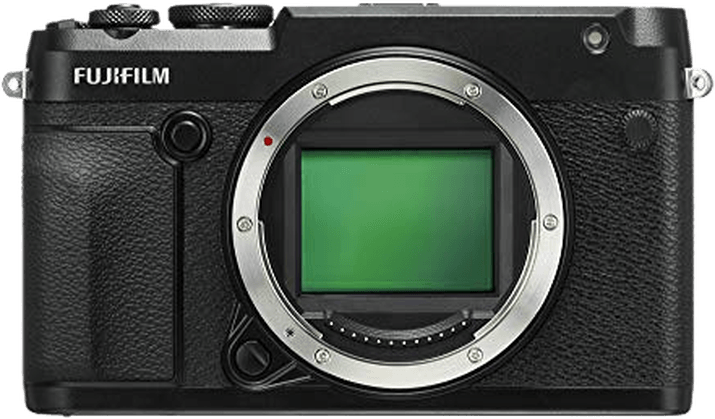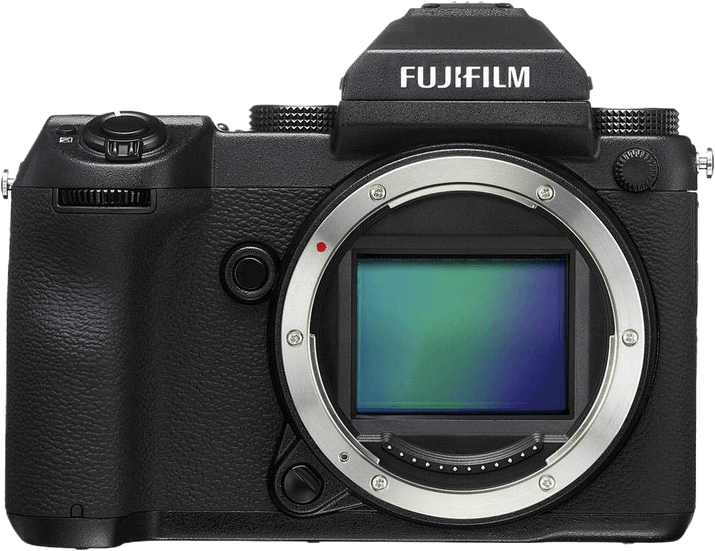Fujifilm GFX 50R vs GFX 50S Comparison
Fujifilm GFX 50R

Fujifilm GFX 50S

The Fujifilm GFX 50S takes the lead with a score of 78/100, compared to the Fujifilm GFX 50R‘s 76/100. Both cameras are mirrorless and were released in 2016 and 2018, respectively. They share common features, such as similar camera sizes and weights. The GFX 50S is slightly smaller at 148 x 94 x 91mm and heavier at 920g, while the GFX 50R measures 161 x 97 x 66mm and weighs 775g.
The winning camera, the GFX 50S, stands out with its higher score, reflecting its better performance. However, the GFX 50R has its advantages, such as a lower launch price of $4499 compared to the GFX 50S’s $6499. This makes the GFX 50R a more budget-friendly option.
Taking these factors into account, the Fujifilm GFX 50S is a superior camera in terms of performance, while the Fujifilm GFX 50R offers a more affordable alternative for those seeking quality at a lower price.
Fujifilm GFX 50R vs GFX 50S Overview and Optics
The Fujifilm GFX 50S is the winner in terms of optics, with a score of 77/100, compared to the Fujifilm GFX 50R’s score of 72/100. Both cameras share several specifications, such as 51 megapixels, a shooting speed of 3 fps, a CMOS sensor, the X-Processor Pro, a medium format sensor size, a Fujifilm G lens mount, and no DXOMARK score.
The GFX 50S outperforms the GFX 50R in image stabilization and aspect ratio. The GFX 50S features image stabilization, which helps in producing sharper images by compensating for camera shake, particularly useful in low-light conditions or when using longer focal lengths. Additionally, the GFX 50S has a 3:2 aspect ratio, which is more versatile for a variety of shooting situations and compositions, compared to the GFX 50R’s 4:3 aspect ratio.
The GFX 50R, on the other hand, does not offer any significant advantages in terms of optics over the GFX 50S. Both cameras have the same sensor, processor, and lens mount, making them equally capable in these aspects. However, the GFX 50R’s lower score does not necessarily mean it is a bad camera; rather, it simply lacks the additional features found in the GFX 50S.
In comparing the optics of the Fujifilm GFX 50R and GFX 50S, the GFX 50S is the clear winner due to its image stabilization and more versatile aspect ratio. While both cameras share many common specifications, the added features of the GFX 50S make it a more capable option for photographers looking for the best possible image quality.
Fujifilm GFX 50R vs GFX 50S Video Performance
When comparing the Fujifilm GFX 50R and the Fujifilm GFX 50S, it is essential to address their video capabilities. The Fujifilm GFX 50S does not have any video functionality, making it unsuitable for those seeking a camera with video recording options. On the other hand, the Fujifilm GFX 50R offers video capabilities that cater to those interested in capturing moving images.
The Fujifilm GFX 50R has a video score of 57 out of 100. This camera provides Full HD video resolution with maximum dimensions of 1920 x 1080 pixels. The maximum video frame rate is 30 frames per second, allowing for smooth video playback. Additionally, the Fujifilm GFX 50R features built-in time-lapse functionality, enabling users to create dynamic time-lapse videos with ease.
When considering the video capabilities of these two cameras, the Fujifilm GFX 50R is the clear choice for those who require video functionality. The Fujifilm GFX 50S, lacking video capabilities, is not suitable for users who need a camera for video recording purposes. Therefore, the decision between these two cameras depends on the user’s specific needs and preferences in terms of video capabilities.
Fujifilm GFX 50R vs GFX 50S Features and Benefits
The Fujifilm GFX 50R emerges as the winner in this comparison with a feature score of 87 out of 100, while the Fujifilm GFX 50S has a score of 57. Both cameras share several specifications, such as a 3.2-inch screen size, 2,360,000-dot screen resolution, touchscreen capabilities, absence of GPS, and the presence of Wi-Fi and Bluetooth connectivity.
The Fujifilm GFX 50R outperforms the GFX 50S mainly due to its flip screen feature. This provides photographers with more flexibility and ease when composing shots from different angles, making it a valuable asset for various photography styles, including landscape, portrait, and street photography. This advantage enables users to capture images in challenging positions, ultimately enhancing their creative potential.
On the other hand, the Fujifilm GFX 50S does not offer any significant advantages over the GFX 50R in terms of features. Both cameras have the same screen size, screen resolution, and connectivity options. The lack of a flip screen on the GFX 50S makes it less versatile compared to the GFX 50R, limiting its usability in certain shooting situations.
To sum up, the Fujifilm GFX 50R is the better choice when comparing features with the GFX 50S due to its flip screen, providing more versatility and creative freedom for photographers. The GFX 50S does not offer any notable benefits over the GFX 50R, making the latter the more appealing option for those seeking improved camera features.
Fujifilm GFX 50R vs GFX 50S Storage and Battery
The Fujifilm GFX 50R outperforms the Fujifilm GFX 50S in storage and battery, scoring 71/100 compared to 57/100. Both cameras share some common specifications, including two memory card slots, compatibility with SD/SDHC/SDXC (UHS-II) memory cards, a battery life of 400 shots, and the use of NP-T125 battery type.
The Fujifilm GFX 50R excels with its USB charging capability, allowing for more convenient charging options. This feature is absent in the Fujifilm GFX 50S, which makes the 50R a better choice for photographers needing flexibility in charging their camera.
On the other hand, the Fujifilm GFX 50S does not have any advantages over the 50R in terms of storage and battery. Both cameras have the same memory card slots, battery life, and battery type.
Considering the USB charging feature in the Fujifilm GFX 50R, it is the superior choice for photographers who require a more versatile charging option, while the Fujifilm GFX 50S offers no additional benefits in this category.
Fujifilm GFX 50R vs GFX 50S – Our Verdict
Are you still undecided about which camera is right for you? Have a look at these popular comparisons that feature the Fujifilm GFX 50R or the Fujifilm GFX 50S:

